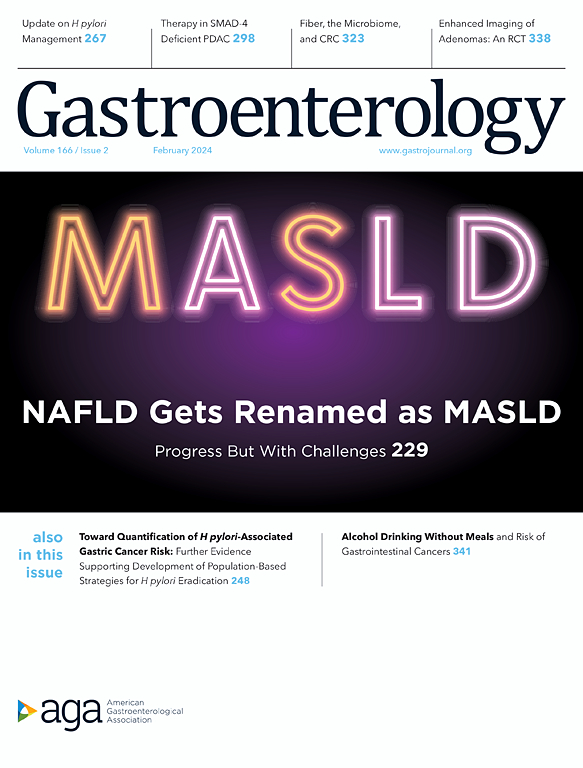KRASG12D cells override homeostatic cell elimination mechanisms in adult pancreas via Wnt5a and cell dormancy.
IF 25.7
1区 医学
Q1 GASTROENTEROLOGY & HEPATOLOGY
引用次数: 0
Abstract
Background and Aims
PaperClipThe adult pancreas protects against cancer by actively expelling genetically mutated cells. Pancreatic cancer starts with cells carrying KRAS mutations; however, it is not clear how some KRAS mutant cells override cell elimination mechanisms to survive in tissues.MethodsWe used an in vivo mouse model of sporadic tumorigenesis to induce Kras and/or Tp53 mutations in low numbers of cells in the adult pancreas. We monitored mutant cell fate over time using quantitative fluorescence imaging. Gene signatures of non-eliminated mutant cell populations were identified using bulk RNA sequencing. Differential gene expression was overlapped with publicly available datasets. Key molecular pathways were validated in murine pancreas using immunofluorescence and functionally tested using inhibitor studies in vivo and epithelial co-culture systems in vitro.ResultsWhile most genetically mutant cells are eliminated from the adult pancreas, a population of KRASG12D- or p53R172H-expressing cells are stably retained. We identify Wnt5a signalling, cell dormancy and stemness as key features of surviving KrasG12D cells in vivo. Wnt5a specifically inhibits apical extrusion of RasV12 cells by promoting stable E-cadherin-based cell-cell adhesions at RasV12: normal cell-cell boundaries in vitro. In the pancreas, Wnt signalling, E-cadherin and β-catenin are increased at cell-cell contacts between non-eliminated KrasG12D cells and normal neighbours. Active Wnt signalling is a general mechanism required to promote KrasG12D and p53R172H cell retention and cell survival in vivo.ConclusionsRAS mutant cells activate Wnt5a and cell dormancy to avoid cell expulsion and to survive in the adult pancreas.

求助全文
约1分钟内获得全文
求助全文
来源期刊

Gastroenterology
医学-胃肠肝病学
CiteScore
45.60
自引率
2.40%
发文量
4366
审稿时长
26 days
期刊介绍:
Gastroenterology is the most prominent journal in the field of gastrointestinal disease. It is the flagship journal of the American Gastroenterological Association and delivers authoritative coverage of clinical, translational, and basic studies of all aspects of the digestive system, including the liver and pancreas, as well as nutrition.
Some regular features of Gastroenterology include original research studies by leading authorities, comprehensive reviews and perspectives on important topics in adult and pediatric gastroenterology and hepatology. The journal also includes features such as editorials, correspondence, and commentaries, as well as special sections like "Mentoring, Education and Training Corner," "Diversity, Equity and Inclusion in GI," "Gastro Digest," "Gastro Curbside Consult," and "Gastro Grand Rounds."
Gastroenterology also provides digital media materials such as videos and "GI Rapid Reel" animations. It is abstracted and indexed in various databases including Scopus, Biological Abstracts, Current Contents, Embase, Nutrition Abstracts, Chemical Abstracts, Current Awareness in Biological Sciences, PubMed/Medline, and the Science Citation Index.
 求助内容:
求助内容: 应助结果提醒方式:
应助结果提醒方式:


